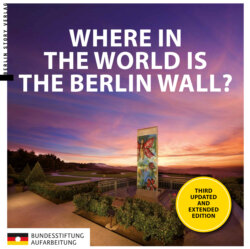Читать книгу Where in the World is the Berlin Wall? - Группа авторов - Страница 19
На сайте Литреса книга снята с продажи.
PEACEFUL REVOLUTION AND THE FALL OF THE WALL 47
ОглавлениеThe domestic political crisis in the GDR reached its peak in 1989. The economy was in a disastrous state and the people were increasingly discontent. The GDR was facing bankruptcy. Since the mid-1980s, opposition groups had emerged and networked. This GDR opposition attempted to establish a counter-public sphere against the SED’s monopoly on opinion and strove to democratize society. GDR citizens looked with interest to the Soviet Union, where Mikhail Gorbachev, as General Secretary of the Central Committee of the Communist Party, had begun a reform process in 1985. His policy of “Glasnost” (openness) and “Perestroika” (transformation) allowed for a previously unthinkable discussion of political and social problems and aimed at increased personal responsibility to solve the serious economic difficulties. Although Gorbachev had opened up his planned economy, his real intention was to improve communism. As far as foreign policy was concerned, he abandoned the Brezhnev Doctrine which had only allowed limited independence of states in the Warsaw Treaty and gave the Soviet Union the right to military intervention if the Socialist system was deemed to be endangered.
Now Gorbachev gave the Eastern bloc countries to understand that they had to manage their affairs independently in the future.
As a result, round table talks were held in Poland in February 1989 which led to the Socialist state holding its first free and democratic elections the following April. Hungary’s rapprochement with the West led to the demonstrative dismantling of the border fence with Austria on May 2nd, 1989, and the “Iron Curtain” got its first hole. In the summer of 1989, thousands of GDR citizens gathered to leave for the West via Hungary. The Hungarian government announced the opening of the border on 10th September 1989 and floods of people began to cross the border.48
Since the GDR had restricted travel to Hungary, the embassies in Prague and Warsaw were occupied. As the situation in the embassies escalated dramatically, citizen’s movements and new parties began to form in the GDR. They countered the demand “We want out” with their slogan “We are staying here” in order to reform the country. Due to the increasing pressure caused by those wishing to flee, the GDR was forced to grant a right of exit to those holding out in the embassies. On 30th September 1989, Hans-Dietrich Genscher, Germany’s foreign minister, announced the right of exit to those in the embassies. The announcement was met with great joy from the people.49 However, the GDR had reserved the right to lead the trains with the refugees through the GDR’s territory in order to be able to formally expatriate them.
When they passed through Leipzig they were met with 5,000 protesters outside the station. The situation ended in riots which were met with a brutal reaction from the police and 1,300 arrests.
Despite the tense situation, the GDR went on celebrating its 40th anniversary whilst the people protested against their government.
On 9th October, when 70,000 people took to the streets, the police did not dare intervene due to the massive numbers of people – the verdict had been reached. The chant “We are the people” spread in no time at all. So-called Monday demonstrations had taken place in many towns in the GDR. On 4th November, half a million people demonstrated against the Government in Berlin and demanded democratic reforms. On 18th October, party and state leader, Erich Honecker, was forced to leave office. Nevertheless, the flow of refugees heading to the West did not slow down. The Czech government put the new GDR leadership under pressure to find a solution to slow down the flow of refugees. A travel act was quickly put together targeted at solving the problem and included rules about leaving the GDR legally. At the same time, efforts were made to make visits to relatives in the West as easy and straightforward as possible. SED official, Günter Schabowski, announced the rules at an international press conference. According to the rules, GDR citizens would be able to apply to leave the GDR without giving a reason and this would also be possible for travel being made to visit family and friends. Schabowski was not well-prepared when one of the journalists asked exactly when these rules would take effect. After a glance at his notes received from the newly appointed party and state leader Egon Krenz, came the decisive answer “immediately, without delay.”50 Reports from the western media were immediately released claiming that the Wall was open. On the very same evening, thousands of GDR citizens made their way to the border. No one informed the border troops on duty about the new regulations or instructions on how to implement them. Nobody was interested in the next announcement stipulating the necessity to apply for passports and visas. Workers at the border crossing on Bornholmer Bridge were faced with thousands of people wanting to cross. They saw no alternative than to open the border immediately. This was the night the Wall fell under pressure from the masses, the word “Wahnsinn” (madness) became the word of 1989.
